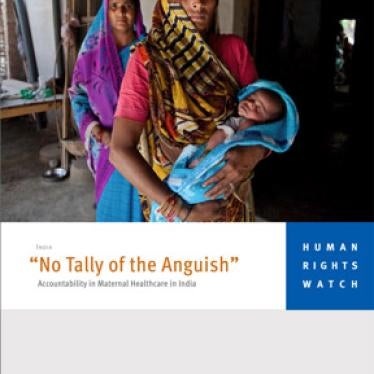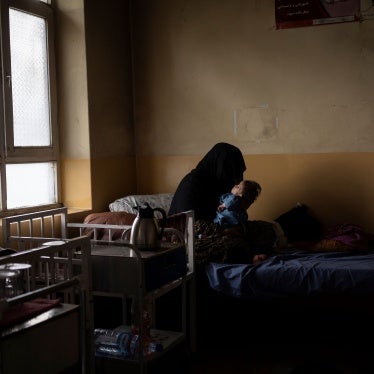(New York) - India is falling behind other countries in meeting international commitments to improve obstetric care because it does not adequately monitor deaths and injuries in the critical period following childbirth and fix gaps in its health system and programs, Human Rights Watch said today.
Representatives from around the world met on October 26, 2009, to review and reaffirm international goals for sexual and reproductive health, including maternal health. Public health experts say that the key to progress in maternal health is ensuring that women with pregnancy complications are able to get appropriate care during childbirth. But Human Rights Watch research shows this is not happening in India even though it has started healthcare programs that guarantee free obstetric care to rural women.
"India should be a leader in protecting and monitoring women's sexual and reproductive health," said Aruna Kashyap, researcher for the Women's Rights Division of Human Rights Watch. "Yet women continue to die entirely preventable deaths, and health authorities do not track down the reasons or do what is needed to rectify the health system."
The government counts the number of births in health clinics and hospitals, but these are often woefully under-resourced and under-staffed. Many women die or suffer serious injury after giving birth under these circumstances. The Indian government does not monitor what happens to women after childbirth, especially in the following 24 to 72 critical hours, when the chances of dying are the highest. Without this information, it cannot save women who go back home and die or develop long-lasting complications.
The Indian government should change its approach to monitoring and examine whether women with pregnancy-related complications are in fact getting the kind of treatment they need and whether they are surviving childbirth in the postpartum period. The Indian government's new Health Management Information System includes some of this data for monitoring, but it remains to be seen whether this data will be consistently collected and utilized for maternal health care programming at district and state levels.
In the "Call to Urgent Action for Maternal Health" issued after the October 26 meeting in Addis Ababa, members of parliaments and civil society representatives from across the world reaffirmed their commitment to goals set out in the landmark 1994 International Conference on Population and Development (ICPD). Key goals include providing universal access to sexual and reproductive health care to all women, reducing preventable deaths from childbirth and unsafe abortions, monitoring implementation, and reporting on progress both locally and globally. India was at this meeting and reaffirmed its commitment to these goals.
In its October report, "No Tally of the Anguish," Human Rights Watch published its findings from research that included interviews with victims, families, medical experts, officials and human rights activists in Uttar Pradesh and elsewhere in India. Uttar Pradesh state in north India has the second highest maternal mortality levels in the country. Human Rights Watch documented cases in which women died after childbirth even though they gave birth in health facilities. In these same districts, government health records showed "zero" deaths.
"The emphasis on ‘results' in the Addis Call to Action is important," Kashyap said. "Counting the number of women who give birth in under-equipped and under-staffed health facilities is meaningless unless the government can show that these women gave birth safely and survived without complications through the immediate postpartum period."
The Indian government promotes giving birth in public health facilities, using cash incentives for poor women, with the goal of providing access to skilled care. But there is little systemic information on whether rural clinics and district hospitals are able to provide adequate and timely care to save women with pregnancy-related complications.
The government treats the huge increase of clinic-based deliveries as progress -20 million women gave birth in health facilities across India between mid-2005 and March 2009. However, there is no reliable information on what percentage of these 20 million women actually survived after childbirth or suffered complications after being discharged.
The Programme of Action of the International Conference on Population and Development requires all births to be attended by skilled birth attendants - health staff trained in midwifery skills and supported by a functional health system including referral systems. However, doctors, nurses, and many women from Uttar Pradesh and public health experts from different parts of India repeatedly told Human Rights Watch about cases of pregnant women seeking emergency obstetric care being sent from one clinic to another desperately seeking care. Poorly equipped health facilities coupled with poor referral systems are serious barriers to timely care for pregnant women.
"Skilled birth attendance and quality of care are two sides of the same coin," Kashyap said. "Unless India can draw up a time-bound plan of action for independent certification and monitoring of public and private health facilities as ‘quality care providers,' there is no guarantee that women giving birth in health facilities are receiving the skilled birth attendance needed to save them."






